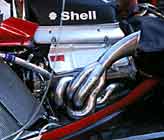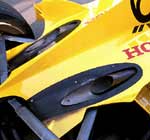Exhaust piping
History
Early 1900s, as piston engines came under the scrutiny of academics, it was noticed that if an engine was run at an RPM such that the firing frequency coincided with the natural frequency of the exhaust system, i.e. the 'note' of the exhaust pipe, a resonance was set up in the pipe.
However, it was not until MIT published a paper on how this phenomenon could be exploited to increase the performance of an engine, that the tuning of exhaust systems really took off. Among the first to experiment with exhaust tuning were the motorcycle engine tuners. In the late 1940s and early 50s, they tried different length exhaust pipes on their single-cylinder Nortons etc to obtain maximum power and to shape the torque curve. There is some evidence that Mercedes-Benz were experimenting with exhaust systems on their pre-War GP cars, but there is no mention of this in any of the books on these cars and the technique was probably not fully understood. It was not until the 2.5l GP cars of the 1950's that we really see exhaust system tuning applied to Formula One racing engines.
Engine performance
The objective of the engine designer is to create a negative pressure at the exhaust valve during the overlap period when both exhaust and intake valves are open. To do this he designs an exhaust system that resonates at a particular RPM, and uses the pressure waves reflected by the ends of the pipes to modify the time history of the pressure at the exhaust valve. By coupling two or more of the cylinders' exhaust primary pipes together, interaction between the pulses created by each cylinder modify the pressure characteristics at any given RPM. The ends of each primary pipe are brought together in a collector, such that their ends are close enough together to interact, and the tail pipe(s) form a secondary resonant system. At the same time, the designer will chose intake lengths to form another resonant system, which also interacts with the exhaust system. When two or more cylinder's exhaust pipes are coupled, the firing order of the engine becomes significant, and the firing order of V10's are chosen as a compromise between exhaust tuning and the torsional dynamics of the crankshaft.
 The frequency of an exhaust pipe is set by its length. The shorter the pipe, the higher the frequency. As engine RPM has risen over the years, the length of the exhaust pipes for a given engine configuration has shortened dramatically.
The frequency of an exhaust pipe is set by its length. The shorter the pipe, the higher the frequency. As engine RPM has risen over the years, the length of the exhaust pipes for a given engine configuration has shortened dramatically.
To accomplish an 'as much as possible' ideal exhaust, some very different factors have to be compared and calculated. Some of these all very important factors are the exhaust and intake geometry, valve timing, exhaust gas temperature, velocity, and RPM all affect the characteristics. Reminding these characteristics, an exhaust system can only be optimised for one certain RPM. The length of the exhaust pipe affects as well the maximum RPM and suppleness of the engine in lower RPM. The exhaust is therefore a compromise between engine power in lower or higher RPM ranges.
Aerodynamic impact
The high velocity of exhaust gases exiting the exhaust pipes makes this flow extremely interesting for aerodynamicists as well. As such, as long as regulations allowed it, Formula One has at times been dominated by teams and designers who found out first where to position the exhaust exit pipes on their cars for maximum downforce.
Historically, Formula One cars have always run the exhaust pipes straight out of the back of the car. Ground effects and turbo engines forced a rethink of that solution and introduced periscope exhaust exits. By 1980 for instance, most cars features two exhaust pipes, positioned close to one another, ejecting exhaust gases centrally underneath the rear wing.
Three years later, Jean Claude Migeot drastically changed this layout by allowing the exhaust pipes of the turbo engine in the Renault RE40 to exit into the rear diffuser. This effectively created the first rear blown diffuser, exploiting the kinetic energy of the exhaust gases to increase the suction effect of the diffuser, and hence increase downforce generated by it. The design was rapidly hooked into by others and kept on being the standard until the late 1990s.
Ever increasing engine revolutions increased this effect through the years. More and more, the throttle sensitivity became a problem, with downforce dropping considerably when the driver suddenly lifted their foot off the throttle. Slowly, designers moved the exhaust exit further backwards, from the diffuser kick line towards the trailing edge to reduce this sensitivity, while trying to maintain its upside.
In 1998, it was Ferrari that introduced a completely new thinking in exhaust positioning. Fuelled by the need to further develop their V10 engine in an attempt to recover the power lost from the more powerful V12s, chassis designers were told to accommodate shorter secondary exhaust pipe lengths.
Apart from pure engine power, Ferrari's eventual periscope exhaust layout was also the result of a quest to move weight forward, on the back of a regulation change reduced the width of the rear tyres, which subsequently pushed Bridgestone into introducing a wider front tyre. The team moved its engine further forward, increasing the distance between exhaust ports and the rear diffuser. In traditional thinking, this would have required even longer exhaust pipes, while the ever increasing speed - by then over 18,000rpm - requested shorter ones.
Ferrari's initial solution, according to Willem Toet, the team's aerodynamic chief at the time, "was to exit the exhausts out of the sides of the bodywork beside and ahead of the rear tyres with an extra panel to protect the tyres from hot exhausts. That’s how the car was launched”. This provided a considerable aerodynamic gain as well, but with a lack of heat resistant materials avialable at the time, bending of - at the time steel - suspension arms couldn't be avoided. Having abandoned that, Ferrari went to "a simple blown diffuser but the performance loss was “noticeable”. We then tried a short pipe leading into but not connected to a secondary pipe but had some fires due to exhaust flame outs off throttle that then caused problems”. The final option was to exit up and out, resulting in the well known periscope or snorkel exhausts. It still proved troublesome in the beginning, as the hotter exhaust plume was still affecting rear suspension strength, but by the end of the year, Ferrari had proven to be able to get the new solution working.
The design allowed for further narrowing of the car's rear end bodywork, and by 2002, all teams had copied the upside exhausts. McLaren and Minardi were the latest teams to make the switch, both forced to do so by their engine suppliers, respectively Mercedes-Ilmor and Asiatech.
 Among the periscope exhaust layouts, two solutions developed as mainstream. The first being similar to Ferrari's initial design of 1998, with the exhaust pipe exiting close to the sidepod's bodywork, surrounded by heat shielding to avoid the surrounding carbon fibre bodywork from burning. Ferrari and McLaren, among others, later adopted protruding exhaust pipes, ejecting exhaust gases further above the sidepods, and reducing the need for heat protection.
Among the periscope exhaust layouts, two solutions developed as mainstream. The first being similar to Ferrari's initial design of 1998, with the exhaust pipe exiting close to the sidepod's bodywork, surrounded by heat shielding to avoid the surrounding carbon fibre bodywork from burning. Ferrari and McLaren, among others, later adopted protruding exhaust pipes, ejecting exhaust gases further above the sidepods, and reducing the need for heat protection.
While sidepod heights reduced through the years, exhaust exists also moved further backwards again, leading into the Red Bull RB5 as its most prominent example. Exhausts on that car exited just ahead and below the upper front wishbones of the rear suspension, sending the exhaust plume to just above the rear diffuser and effectively coming as close to a blown diffuser as one could get, without actually blowing it.
By 2010, Adrian Newey triggered another revolution by relocating the exhausts to the car's floor, creating the Red Bull RB6 that would go on to dominate the season. This sealed the edges of the diffuser so effectively that many teams rapidly developed updates to mimic the design. By the start of 2011, all teams had acknowledged Newey's insight and adopted low exits, marking the end of the periscope exhausts.
Radiator outlet
Another remarkable appearance was re-invented by McLaren. The 'chimney' or 'funnels' in front of the rear wheels do not put out engine exhaust gasses, but rather hot radiator air. Some other teams have copied this novelty in 2001. The principle behind this is actually very simple. On the one hand, the air passing through the radiators isn't specified by the throttle, but it depends on the car speed. Increasing the throttle makes the engine suck move air into it, and thus generates more exhaust gasses. Radiators are only provided by air flowing in, due to the movement of the car. So the effect of engine exhausts is just that little faster on downforce in acceleration then with radiator air. On the other hand, it is very interesting of blowing out this hot air as soon as possible, because it heats op the inside of the car. Keeping the air longer under the bonnet, will increase the engine temperature. We shall see in the future who will have made the best compromise.
